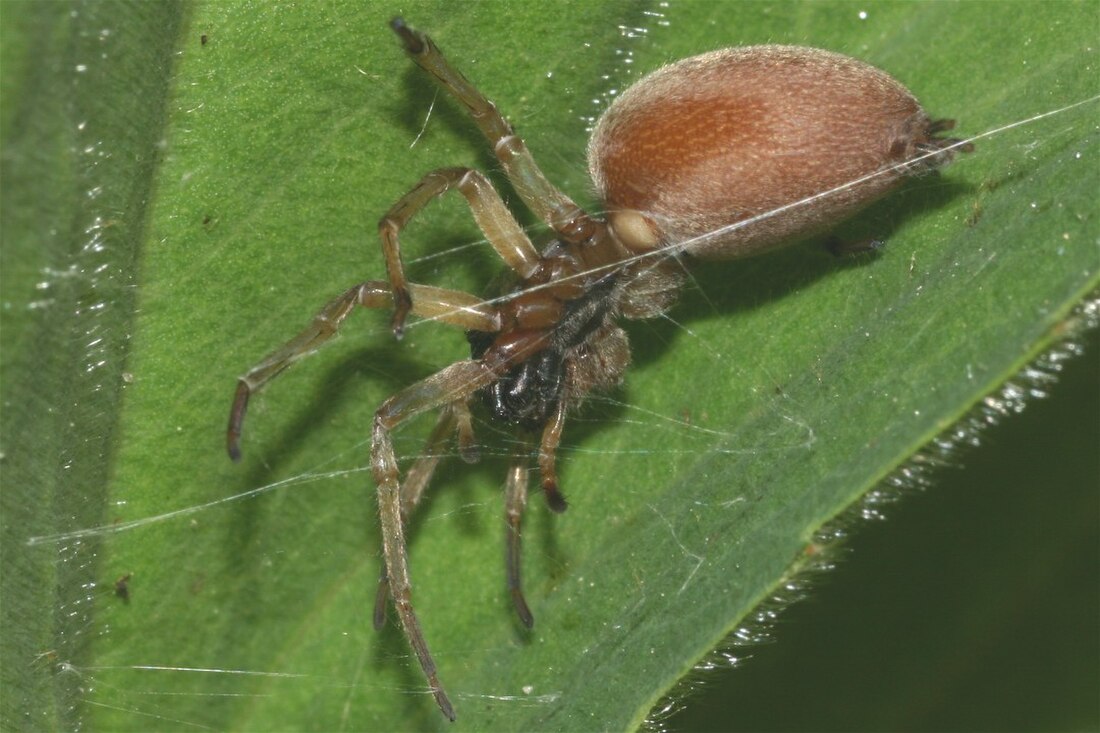Top Qs
Timeline
Chat
Perspective
Sac spider
Family of spiders From Wikipedia, the free encyclopedia
Remove ads
The sac spiders of the family Clubionidae[a] are nocturnal, sac-building hunting spiders with a near-worldwide distribution. Their sacs, silken retreats in which they hide during the day, may be made in a variety of places, including between folded leaves or grass blades, under bark and below rocks or other ground litter.[1]
Although formerly a much larger catch-all taxon, in its current definition the family contains less than 700 described species across 18 genera, of which Clubiona is by far most species-rich, with 528 accepted species as of November 2024[update].[2]
Remove ads
Taxonomy
The Clubionidae have a complex taxonomic history. Historically, the family was a large catch-all taxon for a variety of spiders that shared the following morphological and behavioral similarities: having eight eyes arranged in two rows; having conical anterior spinnerets that touched; and being nocturnal wandering predators that build "sacs" to retreat to during the day.[citation needed]
A large number of genera have been transferred from Clubionidae to other families, and several former subfamilies of the Clubionidae are now treated as separate families.[3] The Zoropsidae, to which genera Anachemmis, Lauricius and Liocranoides were transferred, is much more closely related to the lynx spiders of family Oxyopidae than to the remaining Clubionidae.[4]
According to 2023 cladistic research by Siddharth Kulkarni, Hannah M. Wood and Gustavo Hormiga, the remaining Clubionidae remain polyphyletic as a result of the current placement of genus Elaver.[4]
Remove ads
Genera
- male Clubiona durbana
- Porrhoclubiona leucaspis
As of November 2024[update], the Clubionidae consist of over 665 species in 18 genera worldwide,[5] with by far the majority of species in genus Clubiona.
Genera
Summarize
Perspective
As of October 2025[update], this family includes eighteen genera:[3]
- Arabellata Baert, Versteirt & Jocqué, 2010 – Papua New Guinea
- Bucliona Benoit, 1977 – Kenya, St. Helena, Eastern Asia, Russia
- Clubiona Latreille, 1804 – Africa, Asia, Europe, North America, Oceania, Chile, Guyana
- Clubionina Berland, 1947 – St. Paul Island
- Elaver O. Pickard-Cambridge, 1898 – North America, South America
- Femorbiona Yu & Li, 2021 – China, Vietnam
- Invexillata Versteirt, Baert & Jocqué, 2010 – Papua New Guinea
- Malamatidia Deeleman-Reinhold, 2001 – China, Indonesia, Laos, Malaysia
- Matidia Thorell, 1878 – Asia, New Guinea
- Nusatidia Deeleman-Reinhold, 2001 – China, Southeast Asia, Sri Lanka, Borneo
- Porrhoclubiona Lohmander, 1944 – North Africa, Europe, Asia
- Pristidia Deeleman-Reinhold, 2001 – China, Taiwan, Indonesia, Malaysia, Thailand
- Pteroneta Deeleman-Reinhold, 2001 – China, Japan, Southeast Asia, Australia, New Guinea
- Ramosatidia Yu & Li, 2021 – China
- Scopalio Deeleman-Reinhold, 2001 – Borneo
- Simalio Simon, 1897 – Philippines, India, Sri Lanka, Trinidad
- Sinostidia Yu & Li, 2021 – China
- Tixcocoba Gertsch, 1977 – Mexico
Additionally, the World Spider Catalog considers Carteroniella Strand, 1907 to be a nomen dubium.[6]
See also
Notes
- the term "sac spider" is also part of the common name of various non-clubionid spiders—such as yellow sac spiders (Cheiracanthiidae) or corinnid sac spiders (Corinnidae)—many of which were formerly included in Clubionidae
References
External links
Wikiwand - on
Seamless Wikipedia browsing. On steroids.
Remove ads





